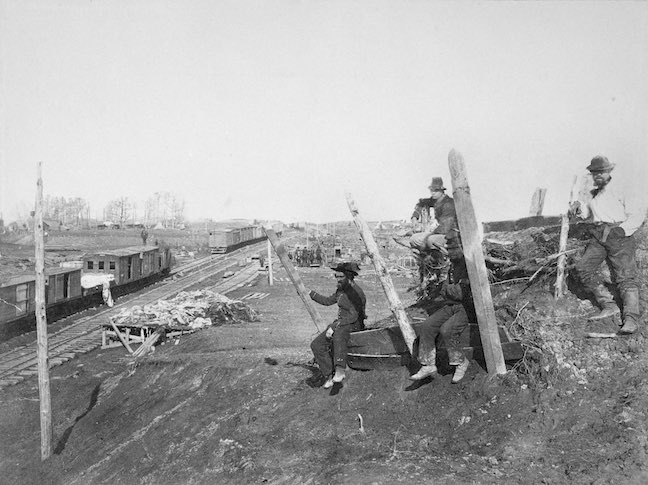| Credit: | by Barnard & Gibson |
|---|---|
| Date: | 1862.03 |
| Negative Size: | 8 in. x 10 in. |
| Equipment: | horse, pipe; Sibley tent; telegraph pole; wedge tent |
| Locations & Lines: | Manassas Junction VA; Orange & Alexandria Railroad (O&A); Virginia |
| Military Units: | CS Army; US Army |
| Transports: | boxcar; flatcar; stock car |
| Sources: | Chrysler Museum of Art; Library of Congress; National Archives; USAMHI – MOLLUS collection |
$6.99
File Details: ACVSm, 800 DPI, TIFF, Original Photograph, 40.2 Mb
Image ID: ACVS
Gardners Photographic Sketch Book Of The War. Vol. 1, No. 10. Manassas Junction. March, 1862. Manassas, the junction of the Orange and Alexandria and Manassas Gap Railroads, twenty-seven miles from Alexandria, strikes the attention of the visitor at once by its remarkable strength as a military position. High table land, flanked by dense wood, and bounded on all sides by deep, treacherous streams, or precipitous bluffs, no better place could have been selected by the Confederates for a permanent camp from which to harrass [sic] an enemy or repel attack. To this point the Southern levies were hastened immediately after the fall of Sumter, and the village of half a dozen houses soon became the center of a vast camp, which, though nearly overwhelmed by the attack of July 21, 1861, remained increasing in strength until March, 1862, when the movements of General McClellan compelled its abandonment. The sense of devastation after the evacuation was terrible. Of the pleasant village only tottering chimneys were left, surrounded by blackened ruins, and the debris of half-burned cars and storehouses.
The forts sere dismantled, broken wagons were strewn over the fields, and quartermaster and commissary stores smoked in all directions, presenting one wide area of desolation, but a small portion of which can be represented in a single photograph.
Such material as had not been wholly destroyed by the fire was speedily removed by the Government. Federal camps were established, and with the return of spring much of that which disfigured the landscape utterly disappeared. The view of the adjacent country from this pint is very fine, and the historic fields of Bull Run, Gainesville, and Groveton, within a few minutes drive, will forever attract the tourist to this spot.
Some prints were produced from reduction copy negatives that shrank them to gallery card (or faux stereo card) size.

